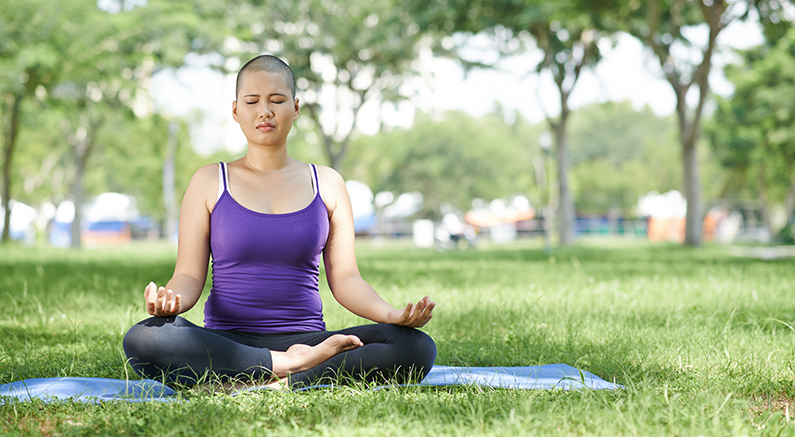If you’re recovering from breast cancer, the medicines that are part of your treatment program can have unwanted effects. You and your oncologist have chosen a path for your breast cancer treatment, but it’s also important to add things to your routine that will help you feel better both mentally and physically. These are called complementary therapies. Yoga is an exercise and breathing therapy that has been proven to help breast cancer patients and survivors.
What is Yoga?
Originating in India over 5,000 years ago, yoga began as a complete lifestyle that combined exercise with ethics and meditation. Today, there are many different forms of yoga. Most types practiced in the U.S. focus on the effects of controlled breathing and exercise without the expectation of a lifestyle change.
If you’ve seen people with years of experience practice yoga, it may look difficult or even impossible for a beginner, especially if you are ill. However, yoga is designed to be gentle enough for people of all ages at any activity level to participate. With over 100 variations of yoga to choose from, it is possible for each patient to find the right level of activity in a class.
What to Expect
It’s important to seek a beginner’s class if you’re not a regular yogi. And if you are, be sure to talk to your instructor. Or, in many cases, you can find a class meant for cancer patients and survivors. An experienced instructor will have the expertise to work with your limitations. During the class, you will learn a series of stretches or poses and some deep breathing techniques to go along with the exercises. If you’re new to yoga, the poses may feel difficult or awkward at first. Be careful to pay attention to your body and not push past your limits. The stretches should never cause pain.
During the session, your instructor will describe how to manage the poses and offer modified or easier versions for participants who can’t reach the full pose. Sometimes pillows or foam shaped into a block will be used to help you get into a modified position. The instructor may also give deep breathing instructions during the class. Even if you feel clumsy and out-of-place at first, yoga can be relaxing and enjoyable.
Benefits of Yoga for Patients with Breast Cancer
Many studies have been conducted on the benefits of yoga for patients recovering from breast cancer. Since yoga poses can be adapted for all levels of fitness, patients who are unable to participate in more demanding exercises can often participate in yoga and feel the positive effect it can have.
A study conducted on 200 women showed significant improvements in the long-term effects of fatigue and inflammation many patients experience in the months following rigorous treatments for breast cancer. Additional smaller studies have shown many positive benefits for patients in all levels of treatment. Some of these benefits include:
- Increased sleep quality. All forms of exercise help improve restful sleep. However, it is likely that the calming effects of deep breathing and a meditative state used in the practice of yoga enhance these benefits.
- Decreased stress and anxiety. A cancer diagnosis obviously brings about considerable anxiety. Treatment can multiply this effect since it has such a large impact on the body. Yoga forces the mind to concentrate on the body which helps quiet the mind and promote a feeling of calm.
- Improved function and mobility. Inflammation and neuropathy associated with treatment can limit mobility. Yoga increases oxygen and circulation throughout the body helping to eliminate this.
- Decreased fatigue. Breast cancer treatment can be particularly harsh on the body, and it’s common for patients to suffer severe fatigue and a decline in respiratory fitness. Yoga helps eliminate these effects avoiding a long-term cycle of lowered energy.
- Reduced depression. From diagnosis, to treatment, to recovery; cancer is a battle every step of the way. Depression is common in all long-term illnesses and cancer is no exception. The improvement in physical symptoms and the ability to participate in a group activity can help relieve this depression.
- Improved quality of life. An improvement in physical symptoms can lead to the ability for patients to participate more in other aspects of their life. Restful sleep and decreased anxiety lead to increased happiness as well.
Potential Complications
When beginning any kind of exercise program or alternative treatment, it’s important to talk to your doctor. Many patients with breast cancer can participate in the yoga program they choose. However, sometimes there are important complications to consider.
Personal Limits
Treatment for breast cancer can cause extreme fatigue and a reduction in respiratory fitness. If beginning yoga classes are too tough to handle, you may need to ask your instructor about restorative yoga (a gentle form of yoga designed for healing).
It’s common for breast cancer to metastasize (spread) to other parts of the body. These cases sometimes require additional treatment or other risks to consider. Many patients suffering from breast cancer have lymph nodes removed. This can lead to an increased risk of lymphedema when strenuous activities are performed. Lymphedema is a condition that causes swelling due to a build-up of lymph fluid in other areas of the body. Sometimes, breast cancer spreads to the bones. This could lead to an increased risk of fracture. It’s important to discuss these concerns with your doctor and your yoga instructor before beginning yoga sessions. It may be necessary to adapt your routine to fit your personal needs.
Qualified Instructors
There is a wide range of difference in the level of qualifications of yoga instructors. Some instructors may study the practice for only days while others have years of training. If you’re unsure of the classes available, ask your oncologist to recommend a qualified teacher. Some yoga programs are even targeted toward cancer patients and may be able to help you with costs that aren’t covered by traditional insurance.



